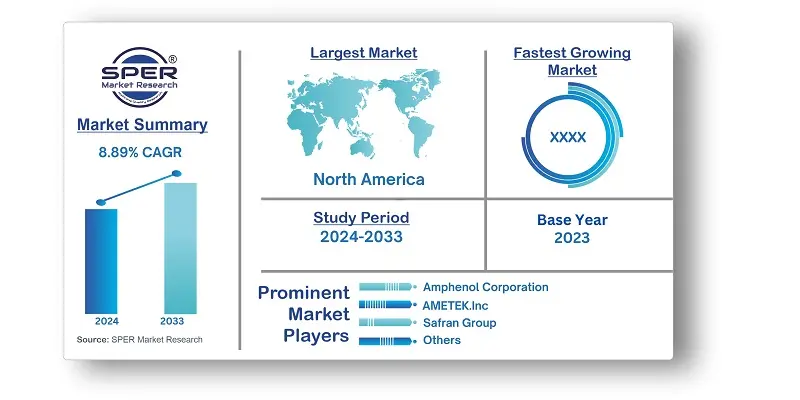
Aircraft Electrical Distribution System Market Growth, Size, Trends, Share and Future Outlook
Aircraft Electrical Distribution System Market Size- By Component, By System, By End User- Regional Outlook, Competitive Strategies and Segment Forecast to 2033
| Published: May-2024 | Report ID: AERO2418 | Pages: 1 - 212 | Formats*: |
| Category : Aerospace and Defence | |||
- Sept 2023: Safran and Cuberg, a California-based division of Swedish battery producer Northvolt, collaborated in September 2023. The alliance intends to create energy storage solutions for electric and hybrid aircraft by utilizing the combined knowledge of the two firms.
- July 2023: Crane Aerospace and Electronics and Heart Aerospace, a Swedish manufacturer of electric airplanes, announced in July 2023 that they would be working together to develop the Electrical Power Distribution System on Heart's ES-30 regional electric aircraft.


| Report Metric | Details |
| Market size available for years | 2020-2033 |
| Base year considered | 2023 |
| Forecast period | 2024-2033 |
| Segments covered | By Component, By System, By End Use. |
| Regions covered | North America, Asia-Pacific, Latin America, Middle East & Africa and Europe |
| Companies Covered | Amphenol Corporation, AMETEK.Inc., Astronics Corporation, Crane Aerospace & Electronics, Collins Aerspace, General Electric, Honeywell International Inc., PARKER HANNIFIN CORP., Safran Group, Thales. |
- Aircraft Manufacturers
- Aerospace Engineers and Designers
- Airlines and Fleet Operators
- Aviation Regulatory Bodies
- Defense Departments and Military Organizations
- Aerospace Component Suppliers
- Aircraft Maintenance, Repair, and Overhaul (MRO) Providers
- Investors and Financial Analysts
- Aviation Consultants and Market Analysts
- Academia and Research Institutions
| By Component: |
|
| By System: |
|
| By End Use: |
|
- Global Aircraft Electrical Distribution System Market Size (FY’2024-FY’2033)
- Overview of Global Aircraft Electrical Distribution System Market
- Segmentation of Global Aircraft Electrical Distribution System Market By Component (Electric Bus, Battery, Generator, Others)
- Segmentation of Global Aircraft Electrical Distribution System Market By System (Power Generation, Power Generation, Power Conversion, Energy Storage)
- Segmentation of Global Aircraft Electrical Distribution System Market By End Use (Commercial, Defense)
- Statistical Snap of Global Aircraft Electrical Distribution System Market
- Expansion Analysis of Global Aircraft Electrical Distribution System Market
- Problems and Obstacles in Global Aircraft Electrical Distribution System Market
- Competitive Landscape in the Global Aircraft Electrical Distribution System Market
- Impact of COVID-19 and Demonetization on Global Aircraft Electrical Distribution System Market
- Details on Current Investment in Global Aircraft Electrical Distribution System Market
- Competitive Analysis of Global Aircraft Electrical Distribution System Market
- Prominent Players in the Global Aircraft Electrical Distribution System Market
- SWOT Analysis of Global Aircraft Electrical Distribution System Market
- Global Aircraft Electrical Distribution System Market Future Outlook and Projections (FY’2024-FY’2033)
- Recommendations from Analyst
1.1. Scope of the report1.2. Market segment analysis
2.1. Research data source2.1.1. Secondary Data2.1.2. Primary Data2.1.3. SPER’s internal database2.1.4. Premium insight from KOL’s2.2. Market size estimation2.2.1. Top-down and Bottom-up approach2.3. Data triangulation
4.1. Driver, Restraint, Opportunity and Challenges analysis4.1.1. Drivers4.1.2. Restraints4.1.3. Opportunities4.1.4. Challenges4.2. COVID-19 Impacts of the Global Aircraft Electrical Distribution System Market.
5.1. SWOT Analysis5.1.1. Strengths5.1.2. Weaknesses5.1.3. Opportunities5.1.4. Threats5.2. PESTEL Analysis5.2.1. Political Landscape5.2.2. Economic Landscape5.2.3. Social Landscape5.2.4. Technological Landscape5.2.5. Environmental Landscape5.2.6. Legal Landscape5.3. PORTER’s Five Forces5.3.1. Bargaining power of suppliers5.3.2. Bargaining power of buyers5.3.3. Threat of Substitute5.3.4. Threat of new entrant5.3.5. Competitive rivalry5.4. Heat Map Analysis
6.1. Global Aircraft Electrical Distribution System Market Manufacturing Base Distribution, Sales Area, Product Type6.2. Mergers & Acquisitions, Partnerships, Product Launch, and Collaboration in Global Aircraft Electrical Distribution System Market
7.1. Global Aircraft Electrical Distribution System Market Size, Share and Forecast, By Component, 2020-20267.2. Global Aircraft Electrical Distribution System Market Size, Share and Forecast, By Component, 2027-20337.3. Electric Bus7.4. Battery7.5. Generator7.6. Others
8.1. Global Aircraft Electrical Distribution System Market Size, Share and Forecast, By System, 2020-20268.2. Global Aircraft Electrical Distribution System Market Size, Share and Forecast, By System, 2027-20338.3. Power Generation8.4. Power Distribution8.5. Power Conversion8.6. Energy Storage
9.1. Global Aircraft Electrical Distribution System Market Size, Share and Forecast, By End Use, 2020-20269.2. Global Aircraft Electrical Distribution System Market Size, Share and Forecast, By End Use, 2027-20339.3. Commercial9.4. Defense
10.1. Global Aircraft Electrical Distribution System Market Size and Market Share
11.1. Global Aircraft Electrical Distribution System Market Size and Market Share By Region (2020-2026)11.2. Global Aircraft Electrical Distribution System Market Size and Market Share By Region (2027-2033)11.3. Asia-Pacific11.3.1. Australia11.3.2. China11.3.3. India11.3.4. Japan11.3.5. South Korea11.3.6. Rest of Asia-Pacific11.4. Europe11.4.1. France11.4.2. Germany11.4.3. Italy11.4.4. Spain11.4.5. United Kingdom11.4.6. Rest of Europe11.5. Middle East and Africa11.5.1. Kingdom of Saudi Arabia11.5.2. United Arab Emirates11.5.3. Qatar11.5.4. South Africa11.5.5. Egypt11.5.6. Morocco11.5.7. Nigeria11.5.8. Rest of Middle East & Africa11.6. North America11.6.1. Canada11.6.2. Mexico11.6.3. United States11.7. Latin America11.7.1. Argentina11.7.2. Brazil11.7.3. Rest of Latin America
12.1. Amphenol Corporation12.1.1. Company details12.1.2. Financial outlook12.1.3. Product summary12.1.4. Recent developments12.2. AMETEK.Inc.12.2.1. Company details12.2.2. Financial outlook12.2.3. Product summary12.2.4. Recent developments12.3. Astronics Corporation12.3.1. Company details12.3.2. Financial outlook12.3.3. Product summary12.3.4. Recent developments12.4. Crane Aerospace & Electronics12.4.1. Company details12.4.2. Financial outlook12.4.3. Product summary12.4.4. Recent developments12.5. Collins Aerospace12.5.1. Company details12.5.2. Financial outlook12.5.3. Product summary12.5.4. Recent developments12.6. General Electric12.6.1. Company details12.6.2. Financial outlook12.6.3. Product summary12.6.4. Recent developments12.7. Honeywell International Inc.12.7.1. Company details12.7.2. Financial outlook12.7.3. Product summary12.7.4. Recent developments12.8. PARKER HANNIFIN CORP.12.8.1. Company details12.8.2. Financial outlook12.8.3. Product summary12.8.4. Recent developments12.9. Safran Group12.9.1. Company details12.9.2. Financial outlook12.9.3. Product summary12.9.4. Recent developments12.10. Thales12.10.1. Company details12.10.2. Financial outlook12.10.3. Product summary12.10.4. Recent developments12.11. Others
SPER Market Research’s methodology uses great emphasis on primary research to ensure that the market intelligence insights are up to date, reliable and accurate. Primary interviews are done with players involved in each phase of a supply chain to analyze the market forecasting. The secondary research method is used to help you fully understand how the future markets and the spending patterns look likes.
The report is based on in-depth qualitative and quantitative analysis of the Product Market. The quantitative analysis involves the application of various projection and sampling techniques. The qualitative analysis involves primary interviews, surveys, and vendor briefings. The data gathered as a result of these processes are validated through experts opinion. Our research methodology entails an ideal mixture of primary and secondary initiatives.



Frequently Asked Questions About This Report
PLACE AN ORDER
Year End Discount
Sample Report
Pre-Purchase Inquiry
NEED CUSTOMIZATION?
Request CustomizationCALL OR EMAIL US
100% Secure Payment






Related Reports
Our Global Clients
Our data-driven insights have influenced the strategy of 200+ reputed companies across the globe.




















